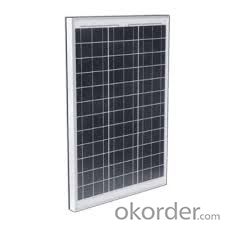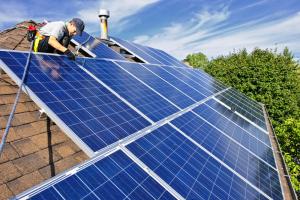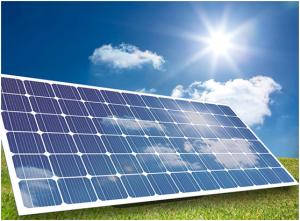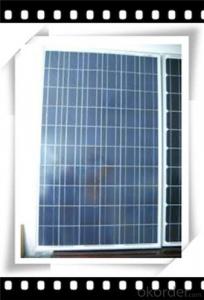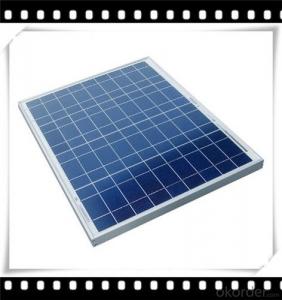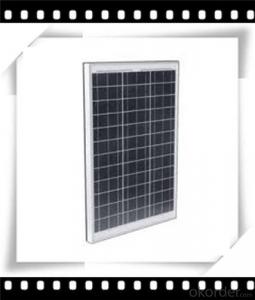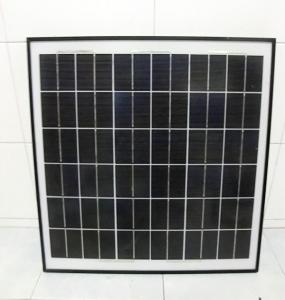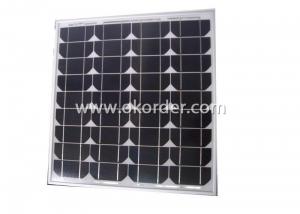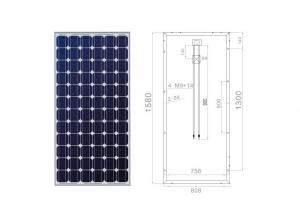Best Solar Panels Portable 80W Poly Solar Panel Small Poly Solar Panel CNBM
- Loading Port:
- Qingdao
- Payment Terms:
- TT OR LC
- Min Order Qty:
- 10 set
- Supply Capability:
- 300000 set/month
OKorder Service Pledge
OKorder Financial Service
You Might Also Like
Polycrystalline Solar Modules
CNBM offers a range of small, medium and large polycrystalline solar modules, designed for a range of requirements.
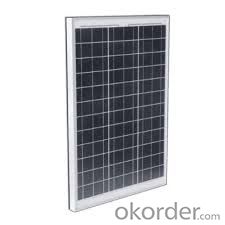
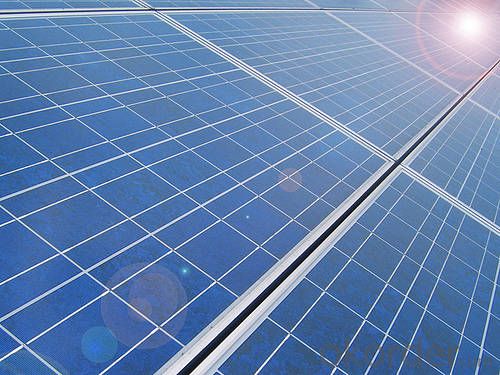
Specifications:
Tolerance | +/-3% |
Cell | Polycrystalline silicon solar cells (156 x 156mm) |
N0. of Cells | 60 (10 x 6) |
Dimension of Modules (mm) | 1650 x 990 x 40 |
Weight (kg) | 25.5 |
Limits:
Operating Temperature | -40~+85? |
Storage Temperature | -40~+85? |
Maximum System Voltage | 1000 VDC max. |
Hail Impact | Diameter of 28mm with impact speed |
Temperature and Coefficients:
NOCT | 48C+/-2? |
Voltage temperature coefficient (%/K) | -0.35 |
Current temperature coefficient (%/K) | 0.05 |
Power temperature coefficient (%/K) | -0.45 |
Characteristics:
Model: | SGM-200P | SGM-210P | SGM-220P |
Max-power voltage Vmp (V) | 29.2 | 29.4 | 29.41 |
Max-power current Imp (A) | 6.85 | 7.14 | 7.48 |
Open-circuit voltage Voc (V) | 36.5 | 36.69 | 36.9 |
Short-Circuit Current Isc (A) | 7.28 | 7.6 | 7.93 |
Max-power Pm(W) | 200 | 210 | 220 |
Model: | SGM-230P |
Max-power voltage Vmp (V) | 29.8 |
Max-power current Imp (A) | 7.72 |
Open-circuit voltage Voc (V) | 37.31 |
Short-Circuit Current Isc (A) | 8.19 |
Max-power Pm(W) | 230 |
STC: Irradiance 1000W/m2, module temperature 25?, AM-=1.5
Poly Crystalline Solar Panels Specifications Range
Maximum Power (Pm) | Dimension | Weight | Operating Voltage (Vmp) | Operating Current (Imp) | Open Circuit Voltage (Voc) | Short Circuit Current (Isc) |
0.45W | 140x80x10mm | 0.08kg | 3.3V | 150mA | 4.6V | 160mA |
1.0W | 162x140x10mm | 0.16kg | 7.5V | 150mA | 10.3V | 160mA |
4.5W | 269x251x23mm | 0.8kg | 16.5V | 0.27A | 20.5V | 0.3A |
10W | 420.1×268.9×22.6mm | 1.92kg | 17.5V | 0.58A | 20.5V | 0.6A |
20W | 425x502x50mm | 3.0kg | 16.8V | 1.19A | 21.0V | 1.29A |
30W | 593x502x22.6mm | 3.9kg | 16.8V | 1.78A | 21.0V | 1.94A |
40W | 655x537x50mm | 5.75kg | 17.3V | 2.31A | 22.1V | 2.54A |
50W | 839x537x50mm | 6.0kg | 17.5V | 2.9A | 21.8V | 3.17A |
65W | 1111x502x50mm | 7.2kg | 17.6V | 3.69A | 22.1V | 3.99A |
80W | 1204x537x50mm | 7.7kg | 17.6V | 4.55A | 22.1V | 4.8A |
- Q: Can solar panels be used to power a gas station?
- Yes, solar panels can be used to power a gas station. Solar energy can be harnessed through the panels and converted into electricity, which can then be used to power various operations and equipment at a gas station. This can help reduce reliance on traditional energy sources and lower the carbon footprint of the gas station.
- Q: Hello, I have been trying to go green, I Have purchase somesolar panel they are about 45watts I been putting it against my window and getting ok power out of it enough for my lights and a couple of low watts gadget (cellphone, 2v light, portable dvd) for couple of hours.But its seem to drain the 2v faster then I can charge Am I getting the most power out of my panel?Or should I place it on the roof? I'm in Texas and it gets hot and sunny the sun beam my room windows pretty good during 4pm-6pm.
- The MOST efficient placement is on a motorized mounting that constantly moves it to face the Sun directly. Almost nobody does that because it is clumsy and expensive. The best fixed position is facing X degrees due south of straight up, where X is your latitude. I am in Austin, at about 30 degrees latitude, so on the south side of a 30 degree pitched roof would be ideal. The direct south facing it the best average to catch morning and afternoon sun, with most efficient pointing at noon. The tilt equal to latitude is the best average between the high Sun in summer and low Sun in winter, with most efficient pointing in spring and fall.
- Q: I think that solar panels are the future and i think that the conventional way of generating electricity is going to be replaced by solar panels. I would like to be part of this industry as an entrepreneur but i do not know how to since i do not have a technical background. I would like to sell solar panels to consumers and to business. Should I start a manufacturing company that manufactures solar panels? Should I buy solar panels from manufactures and sell them to consumers? What should I do?
- Manufacturing your own electrical solar panels is out of the question. They are built much like computer chips and setting up a plant to do this would cost millions of dollars. You could become a solar system installer. These businesses install solar systems on homes and are paid for this service. You will need a significant amount of technical training to do this though, I would guess at least two years (the last thing you would want to do is damage someones home or design a system that is dangerous). I would suggest that you go into business making energy improvements to homes that do not involve solar energy. Most people can get the best value for their money by improving the air tightness of their homes (several tubes of well placed caulk). Other things you could offer would be the upgrading of door, Windows and electrical box seals. Insulation jackets around hot water heaters is also something a small firm could offer home owners. Other energy improvement are also possible and you could offer a whole shopping list of improvements to a customer. Good luck
- Q: What is the impact of hailstorms on solar panels?
- Hailstorms can have a damaging impact on solar panels. The size and velocity of hailstones can cause physical damage to the panels, resulting in cracks, shattered glass, or dislodged components. This can impair the functionality of the panels, reduce their efficiency, and potentially require costly repairs or replacements. Additionally, hailstorms can also pose a risk to the structural integrity of the mounting system, potentially leading to further damage. To mitigate these risks, solar panel installations in hail-prone areas often incorporate protective measures such as tempered glass, polycarbonate shields, or hail guards to minimize the impact of hailstones.
- Q: I'm building a solar panel for the first time and have the tabbed solar cells. I put together 4 strings of 9 cells. And the cells are each 0.55V, 3.6A.Because I'm going to be using the panel indoors and leaning it up against a window pane, I put them in a 24x36 inch poster-size frame. The frame has a plexiglass cover and a thick cardboard backing. My question to you is this. Will the cardboard backing up against the metal underside (positive side) of the solar cells be ok? I don't know if it may catch fire or if holes may burn through when there's full sun.My guess here is it should be ok. But maybe I'm wrong. If I am wrong, or if something should be put in between, please let me know what I should use.Thanks everyone!
- In commercial panels some sort of polymer is often used for backing. With a 2V panel there are 36 cells, which means they can still output about 4V for charging a 2V battery even when hot. The voltage reduces about 2.2mV per degree C per cell. Commercial panels are meant to work up to about 60 degrees C, which is quite normal in the sun. I have found just lying them on the grass the air circulation is reduced, and they get too hot to charge a 2V battery. This means the backing should have good thermal conductivity while being an electrical insulator, as well as mechanical strength. The cells are often encapsulated in a thermosetting plastic first, then laid face down so a liquid polymer can be poured as backing.. I have removed commercial panels from their frames and re-packaged them to work in a very wet environment. I suppose cardboard would work, but it is unlikely to have good cooling so the expected voltage would be lower. As you intend to only operate indoors I suppose it is unlikely you have full sun most of the time anyway, so there could be less heating and less output current accordingly. I think the cardboard is only useful for a short time, and is not strong enough. Temperature wise it is marginal. The link below uses plywood for the backing. The backing is supposed to provide strength too. A sheet of some sort of plastic or laminate (including melamine laminate as in kitchen bench tops) comes to mind too. The cells are supposed to be bonded to the backing for better thermal conductivity. Use silicon RTV to stick cells to the backing, very thinly.
- Q: what direction should solar panels face to get the best exposure of the sun.
- The following links is a sun angle calculator which I find very helpful during my days of doing project about solar panel. The calculator will give you the accurate location of the sun. Solar panel work best when it is directly facing the sun. All you have to do is key in your location details and it will provide you with two most important details: azimuth angle and altitude angle. Azimuth angle is the East angle where the Sun is relative to the South while altitude angle is the tilt angle of the solar panel throughout the day. By using these two angles, you will maximize your exposure of solar panels. However, if you are experiencing rainy or cloudy days, horizontally mounted solar panels is the most efficient.
- Q: Just wondering if it is possible to recycle solar panels and where that would be done. If it is possible, is there a money refund in return. Or would it be better to just take the metal off and get a refund in that way? Looking for basically any answer here.
- yes they are very recyclable, and you would actually be suprised at how much you get back from them just as materials, as there are still very valuable materials in them.... Often solar shops will accept them back for at a fraction of what you paid, as they can send them back to the manufacturer who then do all the material stripping in them and recycle all the materials there. Mainly depends what type of solar panels you have.... Most probably poly-chystalline or mono-chystalline. If they are that cool blue or black psychadelic looking panel also the manufacturing make that effect is also costly so they would probably look to buying that as well.. I would ask a solar shop where it can be done as the silicon in them are still a very prescious substance..... I would definatly not throw them out or pull them apart just yet
- Q: What is the lifespan of solar panel batteries?
- The lifespan of solar panel batteries can vary depending on various factors such as the type and quality of the battery, usage patterns, and maintenance. On average, solar panel batteries generally last between 5 to 15 years. However, with proper care and regular maintenance, some high-quality batteries can last up to 20 years or more.
- Q: I have some property off the grid and am looking to add solar power
- Of okorder /... , and shop the web for the best panels for yourself. p.s. I'd avoid amorphous silicon panels. They may be cheap, but they'll go bad or seriously degrade in just a few years. p.p.s. I'd also avoid internet guides that claim you can make your own panels very cheaply, if you'll just pay them $$ for the information. Those guides don't live up to their advertising.
- Q: My dad owns a restaurant, and we are doing farely well, but we were thinking on installing solar panels to minimize electricity costs (and of course make it greener). My dad would like to hear some numbers on the price in today (August 29/202) and savings he could possibly make over the years. So In Total Here's What I'm Asking:) Would it be hard to install?2) Maintanence?3) Monthly Expense? (None?)4) Price?5) Savings over time?6) Pros/ConsThank you so much!
- Different solar companies install these panels. Check your local area for a free quote. If you don't already have a solar panels for a hot water system yet, consider a thermosiphon design, then you need no electricity to produce hot water. All the other designs require some electricity.
Send your message to us
Best Solar Panels Portable 80W Poly Solar Panel Small Poly Solar Panel CNBM
- Loading Port:
- Qingdao
- Payment Terms:
- TT OR LC
- Min Order Qty:
- 10 set
- Supply Capability:
- 300000 set/month
OKorder Service Pledge
OKorder Financial Service
Similar products
Hot products
Hot Searches
Related keywords


